Camerimage 2019
Rebel without a cause
Interview with cinematographer Marcell Rév, HSC, about his work on the TV Pilot "Euphoria"How did you prepare for such dense and complex work ?
Marcell Rév : I was able to begin thinking about this project very far in advance. I know Sam Levinson, the creator of the series (and director of a number of episodes) because I had shot Assassination Nation with him in 2017. Already at that time, Sam was writing "Euphoria", and we regularly exchanged ideas about what bringing those teenagers’ world to the screen might involve. We even tested some things on set, such as certain camera movements… When HBO gave us the green light, we already had a lot planned out in our minds… We put them into practice, and then pushed them even further as shooting went forward…
The series is adapted from an Israeli series… What remains of the original, in your opinion ?
MR : In fact, Sam Levinson decided not to keep much. For example, from the get-go, he abandoned everything concerning the main murder plot at the center of the story. He only kept the general context, namely a rather free portrait of the generation of young people born in the early 2000s. As far as I’m concerned, I didn’t even watch the original series, so that I could concentrate on Sam’s script and his new characters.
What was your initial idea in terms of the image ?
MR : We wanted a pretty bold image for the series. A reality full of emotion, just like what an adolescent might feel within himself or herself. On the basis of that concept, the series was built on a sort of mix between an extremely contemporary side and a visual adaptation of what Sam’s own adolescence might have been 20 years ago.
It’s not by chance that in the prologue, we discover that the main character of the series, named “Rue", was born on September 11, 2001. Since Sam and I are both the same age (born in ’84), it was easy for us to find common references and to move the cursor to one side or the other in function of the scenes. The other main idea was for us to portray the situation not necessarily in a factual way, but rather to portray the adolescents as they themselves might wish to appear… A more idealized version of themselves than reality.
Like the shot of Jules on his bicycle lost in the night ?
MR : Yes, that is a part of that shot. I’ll admit I was a bit nervous when we shot it… there, nothing was motivated in terms of lighting and I was afraid of pushing the stylization a bit too far… But now I’m so happy we dared to do it. There’s even a repeat of that effect, when she’s biking in the orange grove one or two episodes later… The basic idea was simply to vary the shots. I remember that just before, we’d shot another nighttime bike shot with Rue, and I was just looking for a way not to repeat myself with a cyclical passing of streetlamps above her. I just attached an HMI to the camera car that was in front of her, pointed directly at her, and surrounded by a cinefoil to avoid any leak from the sides… For no other reason than to create a timeless moment, one that emerged from her own private world…
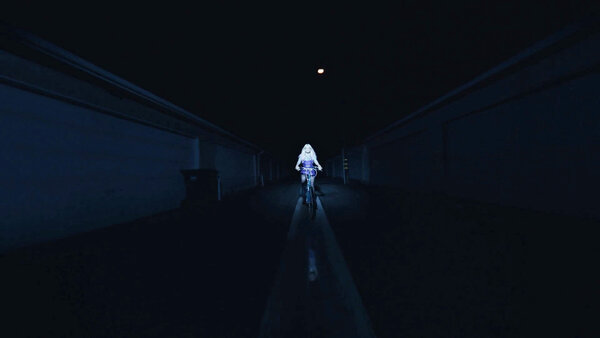
Any influences from other films ?
MR : I would cite Paul Thomas Anderson’s film Magnolia which was often on our minds because of its recurring movements and its editing. I’m especially thinking about its extremely sophisticated editing and connection between the different storylines. In "Euphoria", the camera is almost always moving, unless we’re shooting a long conversation scene… and excepting the sex scenes. We wanted to keep these movements human on the screen…never totally perfect, with either a bit of vibration on the dolly or sometimes even just carried on the shoulder… but they mix very well with one another so that we can construct the flow of scenes from character to character…
In what order did you shoot ?
MR : As on almost all series, we started with the pilot episode (episode 1), on the basis of which the broadcaster approved the rest of the series. Then, I myself shot episodes 3 and 4, and then a part of 2. The rest was handled by other cinematographers. In terms of scenography, we worked as much as we could as though we were shooting a feature film, meaning in a very classical way, with only one camera at a time, using a second camera in parallel in the form of a second crew for all secondary shots and illustrations… Of course, we had to do cross boarding to avoid movements between the various sets, but we did try to respect the chronological order as much as possible. For example, just after the pilot, we had to shoot episode 4 with the big fairground scene and its long takes. A feat that we needed 7 days of shooting to accomplish, 5 of which involved about 400 extras.
Why do these long takes suddenly appear in the scenography of episode 4 ?
MR : It was important for Sam to create a big scene at this pivotal moment of the series (the middle) where all of the protagonists and their respective storylines would come together in a sort of unity of time and place. It was both a visual pause in terms of space and a leap forward in terms of the storytelling. Anecdotally, the fairground was entirely constructed on an empty lot in Pomona by the set design team so that it would perfectly match the dramaturgy imagined by Sam, and so that it could accommodate the different storylines that simultaneously unfold.
For example, this allowed us to set up a 30-meter-long travelling dolly which we used for a part of the party, and then we just turned it around so that we could shoot another scene that was supposed to be taking place at the other end of the set in the film… With this type of decision, we didn’t just capture complicated shots, but we also saved a huge amount of time compared to shooting on location.
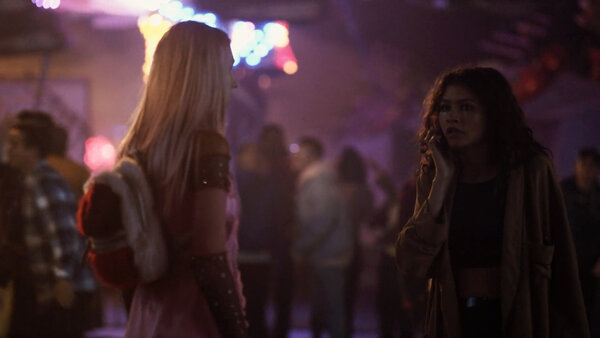
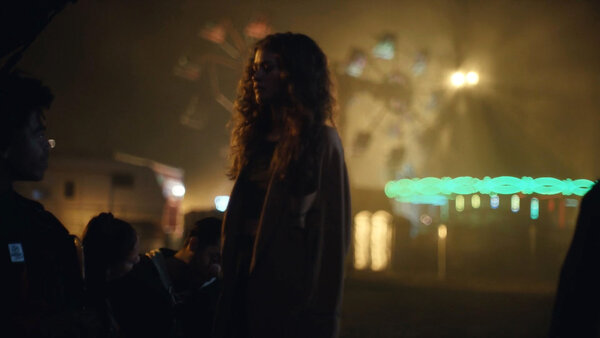
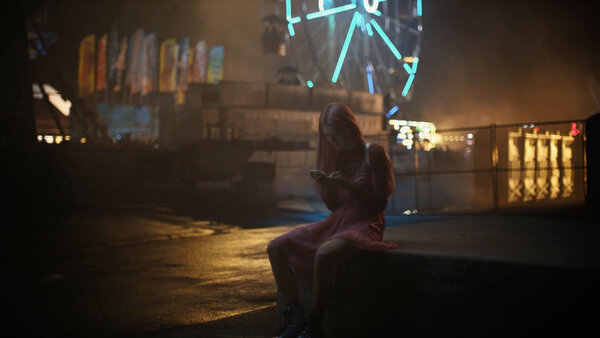
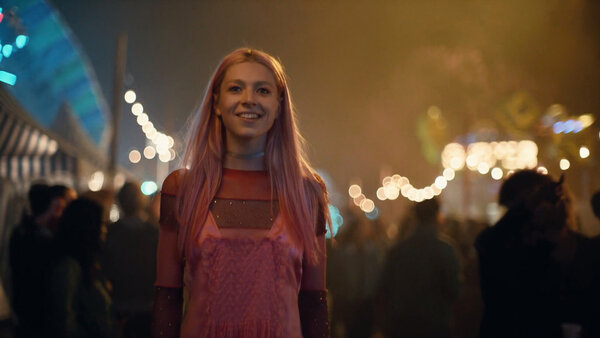
It’s also a very nocturnal series…
MR : Yes, it’s a dark story. A dark subject, and a dark image ! Even when he was writing the script, Sam wanted the series to be dominated by the night. He wanted to bring the plot into the teenagers’ fantasies, with the parties or just the private moments in the protagonists’ home. And then night, especially outdoors, is always the moment when filmmakers can control what they cause the viewer to see…
What camera did you choose ?
MR : Although a few parts used S16 or 35mm film (the introduction or flashbacks), 80% of the series was shot in digital on an Arri Alexa 65. For the very wide format, the choice of lenses was still pretty limited at the time shooting took place and I threw in my lot with the DNA series, which are, in fact – if my information is correct – old 6x6 photo lenses that were rehoused and brought up to the standard of cinema lenses. I love those lenses : thanks to the size of the sensor, they are capable of simultaneously rendering the sensation of a close-up and a medium shot. The strength of the image’s structure, very unlike that of 35mm, the shallow depth of field that you can even adjust in wide shots…all of that participated in creating Euphoria’s image. What I really liked is that these are lenses that are both extremely sharp and yet soft in contrast for faces… They give a halo effect when you take them at full aperture, and this creates a sort of really beautiful flare on screen. The other uncommon thing is that we shot 99% of the series with a single lens, namely the 65mm. For close focusing we first used close-up filters and then at some point Arri gave us a close-focus version of that lens that allowed us to pack the filters away for good.
You were mentioning the very frequent movements but there are sometimes also long pauses in the series’ rhythm… For example, the very long still shot of Rue while she is under the influence of drugs…
MR : That long monologue in close-up is a good example of the changes in rhythm that we tried to provoke in the storytelling. The camera suddenly goes still during that close-up. So, the lighting takes over and changes on her face, in a hyper-stylized way. It becomes a moment outside of time, outside of the party in which the scene is set. This shot was taken at the end of the day, in the backyard of the house chosen for the party scene. We had a very basic setup of several LEDs connected to a console (SkyPanel, Astera) and we just activated a program that had been developed during the afternoon by an operator.
Why blue for the many party scenes ?
MR : Blue was chosen simply because for me, it is synonymous with brutality on the screen. For those scenes, like in episode 1, we were inspired by the pretty hardcore initiation parties that American students organize, and which usually degenerate into challenges or bets drenched in alcohol and drugs. No emotion, just the sound, the bodies, and the brutality of a loveless world. Later, like in episode 6, there is another party scene where blue is still present, but the crew decided to add a few secondary pink or purple colors which are more in the background. A simple and bold way of playing with contrast, just like they used to do in black-and-white films, but this time, in color.
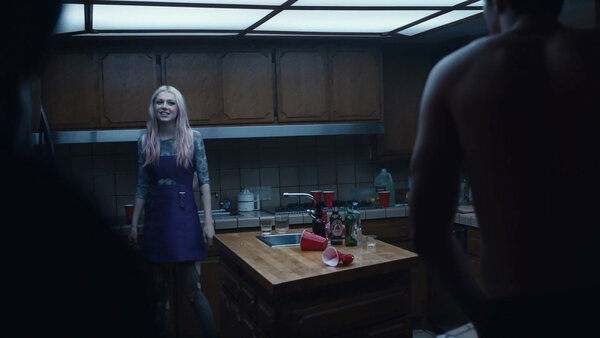

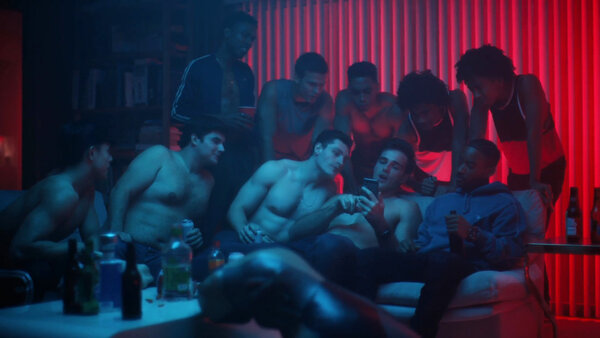
What about the first scene of dialogue between Rue and Jules ?
MR : This was a very pragmatic decision ! I thought it would be clever to play on a balance between warm and cool colors in order to separate both girls while integrating their very different skin colors (Rue, is a mixed-race character, and Jules is a young transgender girl with very pale skin). I had the idea of using the night-effect bluish backlighting (a simple HMI with a light Cyan 30) as key lighting for Rue, while Jules would be lit by the warm backlighting of the porch light (tungsten with amber gelatin).
It creates a lovely contrast. The choice of a master shot in profile naturally contributed to the decision of crosslighting… That is where their alliance is formed.

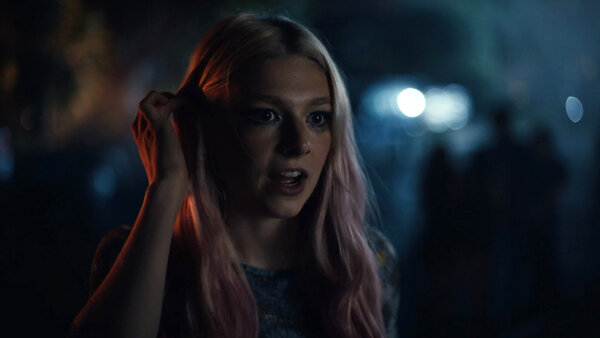
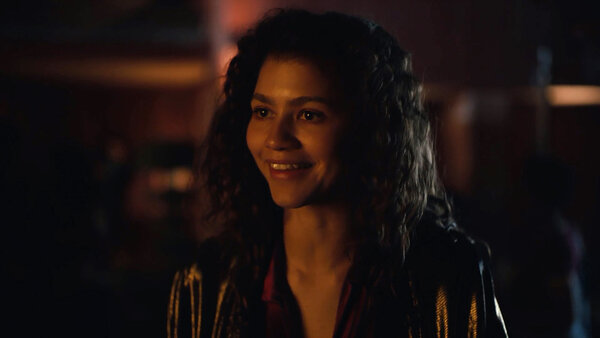
Just before, in the party scene, there is an impressive shot where everything pivots around Rue, upstairs in the house…
MR : This shot was taken on a rotating set, with a Technocrane with tracking that was inside, and all of the extras were attached to the set while it rotated. Only the couple of boys that passes through at the end was added in compositing, after shooting an extra pass using motion control, so that it wouldn’t appear that all of the extras except Rue were still. Not an easy shot, an enormous structure that was very complicated and hard to shoot in 360° in 30 seconds. The motor even had to be changed out at the last minute so that we’d be able to do it !

What is a shot that you’d hold out as illustrative of the entire series ?
MR : Definitely one of the shots in Jules’ bedroom, a high angle shot above the bed. That’s where the entire love story takes shape… A truly simple shot, and perfect for the end of an episode. It’s hard to say why I think it summarizes the whole thing. It’s just something for me that kind of seems to make sense… Love is self-evident.

(Interview conducted by François Reumont on behalf of the AFC, translated from French by A. Baron-Raiffe)
 En
En Fr
Fr






